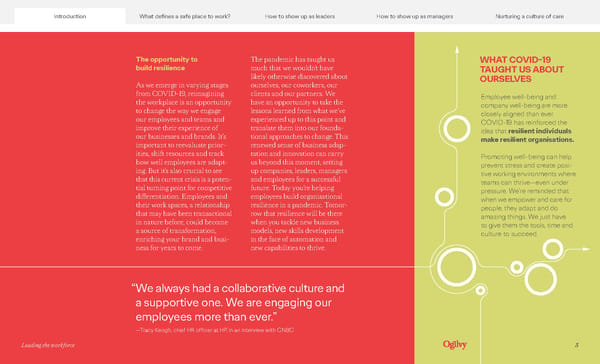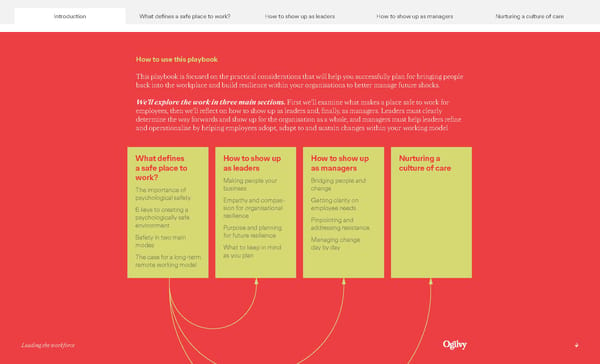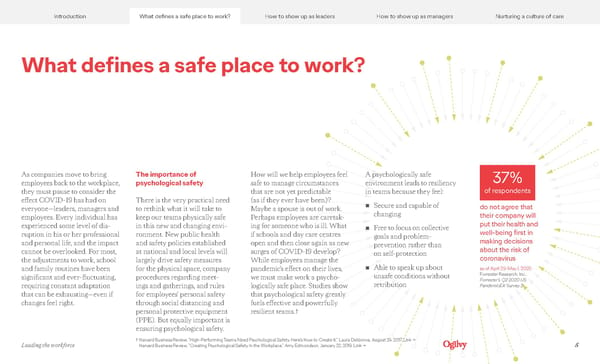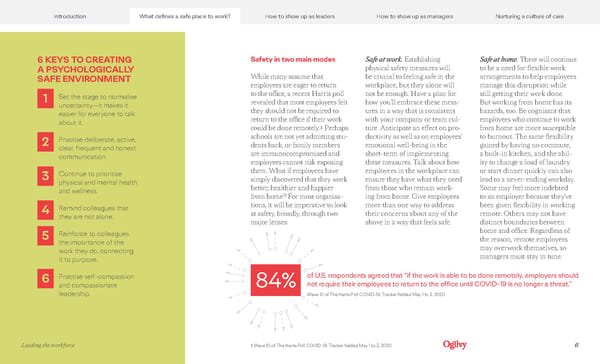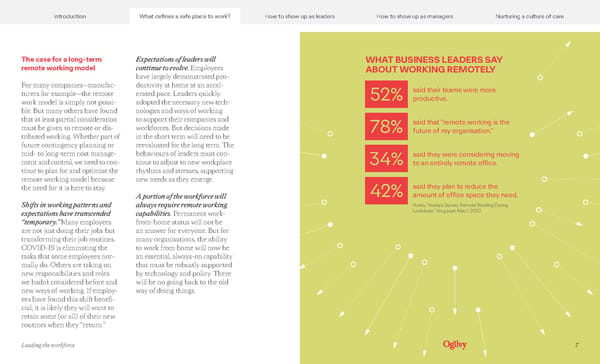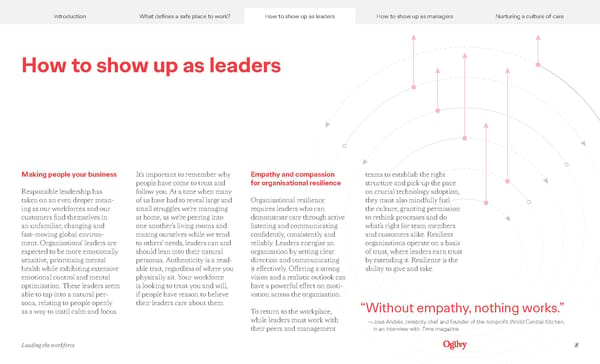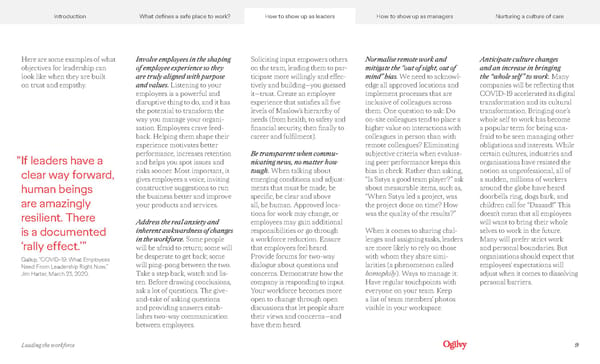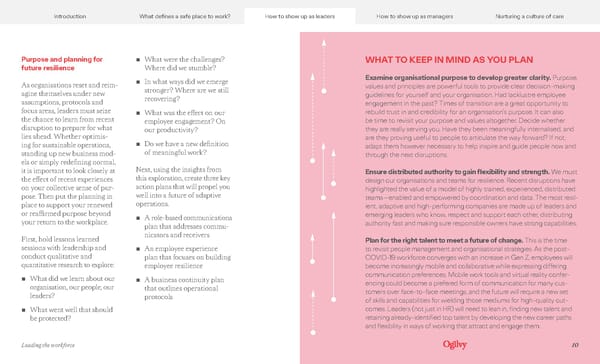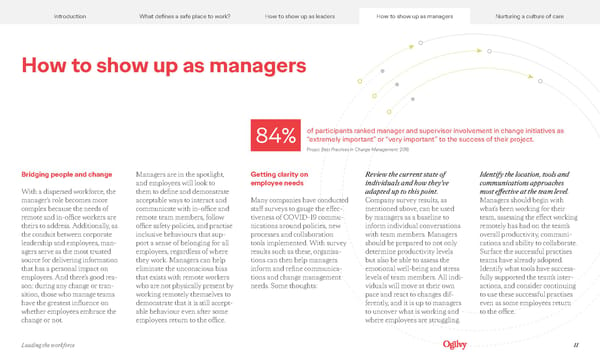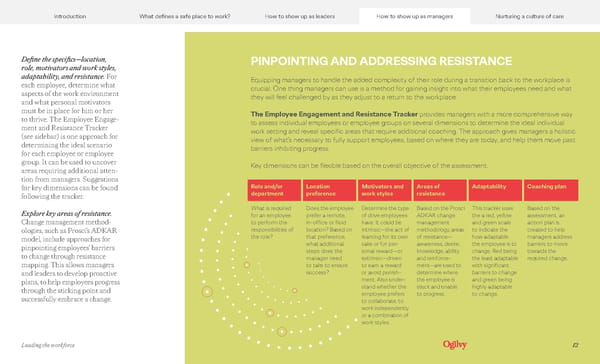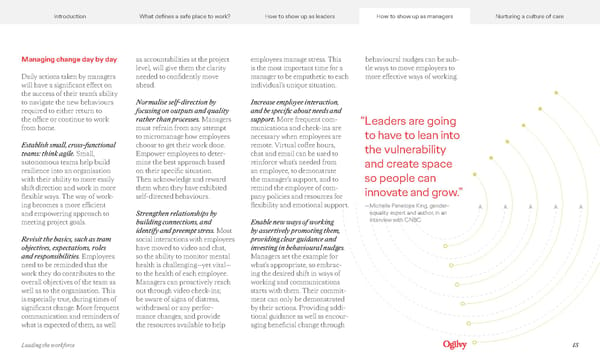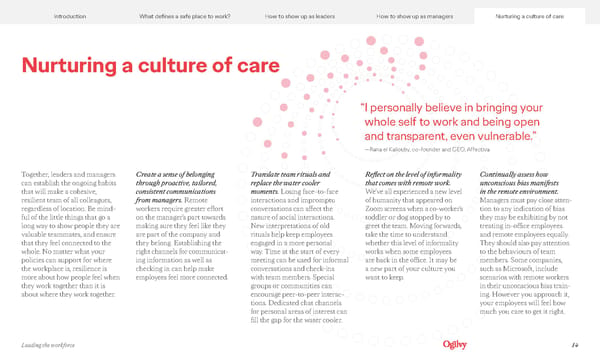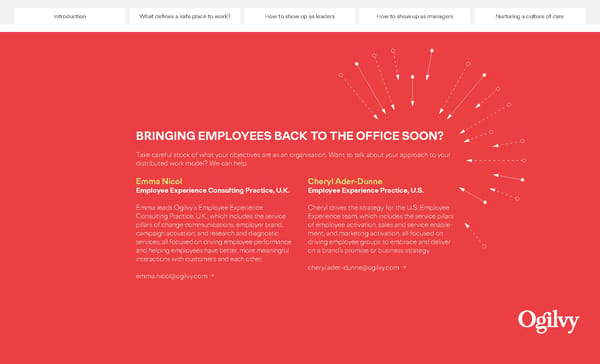New Way of Working
Playbook | Transforming work through COVID-19 | 15 pages
LEADING THE WORKFORCE A playbook for transforming work through COVID-19 created by our Employee Experience Consulting Practice
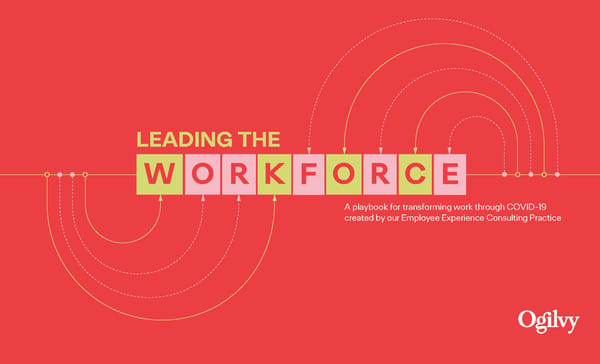
What defines a safe place to work? How to show up as leaders How to show up as managers Nurturing a culture of care Introduction What defines a safe place to work? How to show up as leaders How to show up as managers Nurturing a culture of care THE OPPORTUNITIES IN DISRUPTION COVID-19 has fundamentally changed the social contract 54% between employees and employers. Perhaps more than ever before, it will matter to our people (and customers) whether we of respondents say how demonstrate the desire and the ability to put the safety of employees companies treat their workers is the most important thing and communities first. Providing psychological and physical safety they want to hear from businesses and brands during should be the minimum standard for preparing employees to return, the COVID-19 pandemic whether it’s to an office, a factory line or a retail outlet. Benenson Strategy Group, The Pulse of America: National Omnibus Study, March 2020. Leading the workforce 2
What defines a safe place to work? How to show up as leaders How to show up as managers Nurturing a culture of care Introduction What defines a safe place to work? How to show up as leaders How to show up as managers Nurturing a culture of care The opportunity to The pandemic has taught us WHAT COVID-19 build resilience much that we wouldn’t have TAUGHT US ABOUT likely otherwise discovered about OURSELVES As we emerge in varying stages ourselves, our coworkers, our from COVID-19, reimagining clients and our partners. We Employee well-being and the workplace is an opportunity have an opportunity to take the company well-being are more to change the way we engage lessons learned from what we’ve closely aligned than ever. our employees and teams and experienced up to this point and COVID-19 has reinforced the improve their experience of translate them into our founda- idea that resilient individuals our businesses and brands. It’s tional approaches to change. This make resilient organisations. important to reevaluate prior- renewed sense of business adap- ities, shift resources and track tation and innovation can carry Promoting well-being can help how well employees are adapt- us beyond this moment, setting prevent stress and create posi- ing. But it’s also crucial to see up companies, leaders, managers tive working environments where that this current crisis is a poten- and employees for a successful teams can thrive—even under tial turning point for competitive future. Today you’re helping pressure. We’re reminded that differentiation. Employees and employees build organisational when we empower and care for their work spaces, a relationship resilience in a pandemic. Tomor- people, they adapt and do that may have been transactional row that resilience will be there amazing things. We just have in nature before, could become when you tackle new business to give them the tools, time and a source of transformation, models, new skills development culture to succeed. enriching your brand and busi- in the face of automation and ness for years to come. new capabilities to thrive. “ We always had a collaborative culture and a supportive one. We are engaging our employees more than ever.” — Tracy Keogh, chief HR officer at HP, in an interview with CNBC Leading the workforce 3
What defines a safe place to work? How to show up as leaders How to show up as managers Nurturing a culture of care Introduction What defines a safe place to work? How to show up as leaders How to show up as managers Nurturing a culture of care How to use this playbook This playbook is focused on the practical considerations that will help you successfully plan for bringing people back into the workplace and build resilience within your organisations to better manage future shocks. We’ll explore the work in three main sections. First we’ll examine what makes a place safe to work for employees, then we’ll reflect on how to show up as leaders and, finally, as managers. Leaders must clearly determine the way forwards and show up for the organisation as a whole, and managers must help leaders refine and operationalise by helping employees adopt, adapt to and sustain changes within your working model. What defines How to show up How to show up Nurturing a a safe place to as leaders as managers culture of care work? Making people your Bridging people and The importance of business change psychological safety Empathy and compas- Getting clarity on 6 keys to creating a sion for organisational employee needs psychologically safe resilience Pinpointing and environment Purpose and planning addressing resistance Safety in two main for future resilience Managing change modes What to keep in mind day by day The case for a long-term as you plan remote working model Leading the workforce 4
Introduction How to show up as leaders How to show up as managers Nurturing a culture of care Introduction What defines a safe place to work? How to show up as leaders How to show up as managers Nurturing a culture of care What defines a safe place to work? As companies move to bring The importance of How will we help employees feel A psychologically safe 37% employees back to the workplace, psychological safety safe to manage circumstances environment leads to resiliency they must pause to consider the that are not yet predictable in teams because they feel: of respondents effect COVID-19 has had on There is the very practical need (as if they ever have been)? ▪ Secure and capable of everyone—leaders, managers and to rethink what it will take to Maybe a spouse is out of work. do not agree that employees. Every individual has keep our teams physically safe Perhaps employees are caretak- changing their company will experienced some level of dis- in this new and changing envi- ing for someone who is ill. What ▪ Free to focus on collective put their health and ruption in his or her professional ronment. New public health if schools and day care centres goals and problem- well-being first in and personal life, and the impact and safety policies established open and then close again as new prevention rather than making decisions cannot be overlooked. For most, at national and local levels will surges of COVID-19 develop? on self-protection about the risk of the adjustments to work, school largely drive safety measures While employees manage the coronavirus and family routines have been for the physical space, company pandemic’s effect on their lives, ▪ Able to speak up about as of April 29-May 1, 2020. significant and ever-fluctuating, procedures regarding meet- we must make work a psycho- unsafe conditions without Forrester Research, Inc., retribution Forrester’s Q2 2020 US requiring constant adaptation ings and gatherings, and rules logically safe place. Studies show PandemicEX Survey 2. that can be exhausting—even if for employees’ personal safety that psychological safety greatly changes feel right. through social distancing and fuels effective and powerfully personal protective equipment resilient teams.† (PPE). But equally important is ensuring psychological safety. † Harvard Business Review, “High-Performing Teams Need Psychological Safety. Here’s How to Create It,” Laura Delizonna, August 24, 2017. Link → Leading the workforce Harvard Business Review, “Creating Psychological Safety in the Workplace,” Amy Edmondson, January 22, 2019. Link → 5
Introduction How to show up as leaders How to show up as managers Nurturing a culture of care Introduction What defines a safe place to work? How to show up as leaders How to show up as managers Nurturing a culture of care 6 KEYS TO CREATING Safety in two main modes Safe at work. Establishing Safe at home. There will continue A PSYCHOLOGICALLY physical safety measures will to be a need for flexible work SAFE ENVIRONMENT While many assume that be crucial to feeling safe in the arrangements to help employees employees are eager to return workplace, but they alone will manage this disruption while 1 Set the stage to normalise to the office, a recent Harris poll not be enough. Have a plan for still getting their work done. uncertainty—it makes it revealed that most employees felt how you’ll embrace these meas- But working from home has its easier for everyone to talk they should not be required to ures in a way that is consistent hazards, too. Be cognisant that about it. return to the office if their work with your company or team cul- employees who continue to work could be done remotely.‡ Perhaps ture. Anticipate an effect on pro- from home are more susceptible 2 Practise deliberate, active, schools are not yet admitting stu- ductivity as well as on employees’ to burnout. The same flexibility clear, frequent and honest dents back, or family members emotional well-being in the gained by having no commute, communication. are immunocompromised and short-term of implementing a built-in kitchen, and the abil- employees cannot risk exposing these measures. Talk about how ity to change a load of laundry 3 Continue to prioritise them. What if employees have employees in the workplace can or start dinner quickly can also physical and mental health simply discovered that they work ensure they have what they need lead to a never-ending workday. and wellness. better, healthier and happier from those who remain work- Some may feel more indebted from home? For most organisa- ing from home. Give employees to an employer because they’ve 4 Remind colleagues that tions, it will be imperative to look more than one way to address been given flexibility in working they are not alone. at safety, broadly, through two their concerns about any of the remote. Others may not have major lenses: above in a way that feels safe. distinct boundaries between 5 Reinforce to colleagues home and office. Regardless of the importance of the the reason, remote employees work they do, connecting may overwork themselves, so it to purpose. managers must stay in tune. 6 Practise self-compassion of U.S. respondents agreed that “if the work is able to be done remotely, employers should and compassionate 84% not require their employees to return to the office until COVID-19 is no longer a threat.” leadership. Wave 10 of The Harris Poll COVID-19, Tracker fielded May 1 to 3, 2020. Leading the workforce ‡ Wave 10 of The Harris Poll COVID-19, Tracker fielded May 1 to 3, 2020 6
Introduction How to show up as leaders How to show up as managers Nurturing a culture of care Introduction What defines a safe place to work? How to show up as leaders How to show up as managers Nurturing a culture of care The case for a long-term Expectations of leaders will WHAT BUSINESS LEADERS SAY remote working model continue to evolve. Employees ABOUT WORKING REMOTELY have largely demonstrated pro- For many companies—manufac- ductivity at home at an accel- said their teams were more turers for example—the remote erated pace. Leaders quickly 52% productive. work model is simply not possi- adopted the necessary new tech- ble. But many others have found nologies and ways of working that at least partial consideration to support their companies and said that “remote working is the must be given to remote or dis- workforces. But decisions made 78% future of my organisation.” tributed working. Whether part of in the short term will need to be future contingency planning or reevaluated for the long term. The mid- to long-term cost manage- behaviours of leaders must con- said they were considering moving ment and control, we need to con- tinue to adjust to new workplace 34% to an entirely remote office. tinue to plan for and optimise the rhythms and stresses, supporting remote working model because new needs as they emerge. the need for it is here to stay. 42% said they plan to reduce the A portion of the workforce will amount of office space they need. Shifts in working patterns and always require remote working Hoxby, “Hoxby’s Survey: Remote Working During expectations have transcended capabilities. Permanent work- Lockdown,” blog post, May 1, 2020. “temporary.” Many employees from-home status will not be are not just doing their jobs but an answer for everyone. But for transforming their job routines. many organisations, the ability COVID-19 is eliminating the to work from home will now be tasks that some employees nor- an essential, always-on capability mally do. Others are taking on that must be robustly supported new responsibilities and roles by technology and policy. There we hadn’t considered before and will be no going back to the old new ways of working. If employ- way of doing things. ees have found this shift benefi- cial, it is likely they will want to retain some (or all) of their new routines when they “return.” Leading the workforce 7
Introduction What defines a safe place to work? How to show up as managers Nurturing a culture of care Introduction What defines a safe place to work? How to show up as leaders How to show up as managers Nurturing a culture of care How to show up as leaders Making people your business It’s important to remember why Empathy and compassion teams to establish the right people have come to trust and for organisational resilience structure and pick up the pace Responsible leadership has follow you. At a time when many on crucial technology adoption, taken on an even deeper mean- of us have had to reveal large and Organisational resilience they must also mindfully fuel ing as our workforces and our small struggles we’re managing requires leaders who can the culture, granting permission customers find themselves in at home, as we’re peering into demonstrate care through active to rethink processes and do an unfamiliar, changing and one another’s living rooms and listening and communicating what’s right for team members fast-moving global environ- muting ourselves while we tend confidently, consistently and and customers alike. Resilient ment. Organisations’ leaders are to others’ needs, leaders can and reliably. Leaders energise an organisations operate on a basis expected to be more emotionally should lean into their natural organisation by setting clear of trust, where leaders earn trust sensitive, prioritising mental personas. Authenticity is a read- direction and communicating by extending it. Resilience is the health while exhibiting extensive able trait, regardless of where you it effectively. Offering a strong ability to give and take. emotional control and mental physically sit. Your workforce vision and a realistic outlook can optimisation. These leaders seem is looking to trust you and will, have a powerful effect on moti- able to tap into a natural per- if people have reason to believe vation across the organisation. sona, relating to people openly their leaders care about them. “ Without empathy, nothing works.” as a way to instil calm and focus. To return to the workplace, while leaders must work with — José Andrés, celebrity chef and founder of the nonprofit World Central Kitchen, their peers and management in an interview with Time magazine Leading the workforce 8
Introduction What defines a safe place to work? How to show up as managers Nurturing a culture of care Introduction What defines a safe place to work? How to show up as leaders How to show up as managers Nurturing a culture of care Here are some examples of what Involve employees in the shaping Soliciting input empowers others Normalise remote work and Anticipate culture changes objectives for leadership can of employee experience so they on the team, leading them to par- mitigate the “out of sight, out of and an increase in bringing look like when they are built are truly aligned with purpose ticipate more willingly and effec- mind” bias. We need to acknowl- the “whole self” to work. Many on trust and empathy. and values. Listening to your tively and building—you guessed edge all approved locations and companies will be reflecting that employees is a powerful and it—trust. Create an employee implement processes that are COVID-19 accelerated its digital disruptive thing to do, and it has experience that satisfies all five inclusive of colleagues across transformation and its cultural the potential to transform the levels of Maslow’s hierarchy of them. One question to ask: Do transformation. Bringing one’s way you manage your organi- needs (from health, to safety and on-site colleagues tend to place a whole self to work has become sation. Employees crave feed- financial security, then finally to higher value on interactions with a popular term for being una- back. Helping them shape their career and fulfilment). colleagues in person than with fraid to be seen managing other experience motivates better remote colleagues? Eliminating obligations and interests. While performance, increases retention Be transparent when commu- subjective criteria when evaluat- certain cultures, industries and “ If leaders have a and helps you spot issues and nicating news, no matter how ing peer performance keeps this organisations have resisted the clear way forward, risks sooner. Most important, it tough. When talking about bias in check. Rather than asking, notion as unprofessional, all of gives employees a voice, inviting emerging conditions and adjust- “Is Satya a good team player?” ask a sudden, millions of workers human beings constructive suggestions to run ments that must be made, be about measurable items, such as, around the globe have heard the business better and improve specific, be clear and above “When Satya led a project, was doorbells ring, dogs bark, and are amazingly your products and services. all, be human. Approved loca- the project done on time? How children call for “Daaaad!” This resilient. There tions for work may change, or was the quality of the results?” doesn’t mean that all employees Address the real anxiety and employees may gain additional will want to bring their whole is a documented inherent awkwardness of changes responsibilities or go through When it comes to sharing chal- selves to work in the future. in the workforce. Some people a workforce reduction. Ensure lenges and assigning tasks, leaders Many will prefer strict work ‘rally effect.’” will be afraid to return; some will that employees feel heard. are more likely to rely on those and personal boundaries. But be desperate to get back; some Provide forums for two-way with whom they share simi- organisations should expect that Gallup, “COVID-19: What Employees will ping-pong between the two. dialogue about questions and larities (a phenomenon called employees’ expectations will Need From Leadership Right Now,” Jim Harter, March 23, 2020. Take a step back, watch and lis- concerns. Demonstrate how the homophily). Ways to manage it: adjust when it comes to dissolving ten. Before drawing conclusions, company is responding to input. Have regular touchpoints with personal barriers. ask a lot of questions. The give- Your workforce becomes more everyone on your team. Keep and-take of asking questions open to change through open a list of team members’ photos and providing answers estab- discussions that let people share visible in your workspace. lishes two-way communication their views and concerns—and between employees. have them heard. Leading the workforce 9
Introduction What defines a safe place to work? How to show up as managers Nurturing a culture of care Introduction What defines a safe place to work? How to show up as leaders How to show up as managers Nurturing a culture of care Purpose and planning for ▪ What were the challenges? WHAT TO KEEP IN MIND AS YOU PLAN future resilience Where did we stumble? ▪ In what ways did we emerge Examine organisational purpose to develop greater clarity. Purpose, As organisations reset and reim- stronger? Where are we still values and principles are powerful tools to provide clear decision-making agine themselves under new recovering? guidelines for yourself and your organisation. Had lacklustre employee assumptions, protocols and engagement in the past? Times of transition are a great opportunity to focus areas, leaders must seize ▪ What was the effect on our rebuild trust in and credibility for an organisation’s purpose. It can also the chance to learn from recent employee engagement? On be time to revisit your purpose and values altogether. Decide whether disruption to prepare for what our productivity? they are really serving you. Have they been meaningfully internalised, and lies ahead. Whether optimis- are they proving useful to people to articulate the way forward? If not, ing for sustainable operations, ▪ Do we have a new definition adapt them however necessary to help inspire and guide people now and standing up new business mod- of meaningful work? through the next disruptions. els or simply redefining normal, it is important to look closely at Next, using the insights from Ensure distributed authority to gain flexibility and strength. We must the effect of recent experiences this exploration, create three key design our organisations and teams for resilience. Recent disruptions have on your collective sense of pur- action plans that will propel you highlighted the value of a model of highly trained, experienced, distributed pose. Then put the planning in well into a future of adaptive teams—enabled and empowered by coordination and data. The most resil- place to support your renewed operations. ient, adaptive and high-performing companies are made up of leaders and or reaffirmed purpose beyond ▪ A role-based communications emerging leaders who know, respect and support each other, distributing your return to the workplace. plan that addresses commu- authority fast and making sure responsible owners have strong capabilities. First, hold lessons learned nicators and receivers Plan for the right talent to meet a future of change. This is the time sessions with leadership and ▪ An employee experience to revisit people management and organisational strategies. As the post- conduct qualitative and plan that focuses on building COVID-19 workforce converges with an increase in Gen Z, employees will quantitative research to explore: employee resilience become increasingly mobile and collaborative while expressing differing ▪ What did we learn about our ▪ A business continuity plan communication preferences. Mobile work tools and virtual reality confer- organisation, our people, our that outlines operational encing could become a prefered form of communication for many cus- leaders? protocols tomers over face-to-face meetings, and the future will require a new set of skills and capabilities for wielding those mediums for high-quality out- ▪ What went well that should comes. Leaders (not just in HR) will need to lean in, finding new talent and be protected? retaining already-identified top talent by developing the new career paths and flexibility in ways of working that attract and engage them. Leading the workforce 10
Introduction What defines a safe place to work? How to show up as leaders Nurturing a culture of care Introduction What defines a safe place to work? How to show up as leaders How to show up as managers Nurturing a culture of care How to show up as managers of participants ranked manager and supervisor involvement in change initiatives as 84% “extremely important” or “very important” to the success of their project. Prosci, Best Practices in Change Management, 2018. Bridging people and change Managers are in the spotlight, Getting clarity on Review the current state of Identify the location, tools and and employees will look to employee needs individuals and how they’ve communications approaches With a dispersed workforce, the them to define and demonstrate adapted up to this point. most effective at the team level. manager’s role becomes more acceptable ways to interact and Many companies have conducted Company survey results, as Managers should begin with complex because the needs of communicate with in-office and staff surveys to gauge the effec- mentioned above, can be used what’s been working for their remote and in-office workers are remote team members, follow tiveness of COVID-19 commu- by managers as a baseline to team, assessing the effect working theirs to address. Additionally, as office safety policies, and practise nications around policies, new inform individual conversations remotely has had on the team’s the conduit between corporate inclusive behaviours that sup- processes and collaboration with team members. Managers overall productivity, communi- leadership and employees, man- port a sense of belonging for all tools implemented. With survey should be prepared to not only cations and ability to collaborate. agers serve as the most trusted employees, regardless of where results such as these, organisa- determine productivity levels Surface the successful practises source for delivering information they work. Managers can help tions can then help managers but also be able to assess the teams have already adopted. that has a personal impact on eliminate the unconscious bias inform and refine communica- emotional well-being and stress Identify what tools have success- employees. And there’s good rea- that exists with remote workers tions and change management levels of team members. All indi- fully supported the team’s inter- son: during any change or tran- who are not physically present by needs. Some thoughts: viduals will move at their own actions, and consider continuing sition, those who manage teams working remotely themselves to pace and react to changes dif- to use these successful practises have the greatest influence on demonstrate that it is still accept- ferently, and it is up to managers even as some employees return whether employees embrace the able behaviour even after some to uncover what is working and to the office. change or not. employees return to the office. where employees are struggling. Leading the workforce 11
Introduction What defines a safe place to work? How to show up as leaders Nurturing a culture of care Introduction What defines a safe place to work? How to show up as leaders How to show up as managers Nurturing a culture of care Define the specifics—location, PINPOINTING AND ADDRESSING RESISTANCE role, motivators and work styles, adaptability, and resistance. For Equipping managers to handle the added complexity of their role during a transition back to the workplace is each employee, determine what crucial. One thing managers can use is a method for gaining insight into what their employees need and what aspects of the work environment they will feel challenged by as they adjust to a return to the workplace. and what personal motivators must be in place for him or her The Employee Engagement and Resistance Tracker provides managers with a more comprehensive way to thrive. The Employee Engage- to assess individual employees or employee groups on several dimensions to determine the ideal individual ment and Resistance Tracker work setting and reveal specific areas that require additional coaching. The approach gives managers a holistic (see sidebar) is one approach for view of what’s necessary to fully support employees, based on where they are today, and help them move past determining the ideal scenario barriers inhibiting progress. for each employee or employee group. It can be used to uncover Key dimensions can be flexible based on the overall objective of the assessment. areas requiring additional atten- tion from managers. Suggestions for key dimensions can be found Role and/or Location Motivators and Areas of Adaptability Coaching plan following the tracker. department preference work styles resistance Explore key areas of resistance. What is required Does the employee Determine the type Based on the Prosci This tracker uses Based on the for an employee prefer a remote, of drive employees ADKAR change the a red, yellow assessment, an Change management method- to perform the in-office or fluid have. It could be management and green scale action plan is ologies, such as Prosci’s ADKAR responsibilities of location? Based on intrinsic—the act of methodology, areas to indicate the created to help model, include approaches for the role? that preference, learning for its own of resistance— how adaptable managers address pinpointing employees’ barriers what additional sake or for per- awareness, desire, the employee is to barriers to move to change through resistance steps does the sonal reward—or knowledge, ability change. Red being towards the manager need extrinsic—driven and reinforce- the least adaptable required change. mapping. This allows managers to take to ensure to earn a reward ment—are used to with significant and leaders to develop proactive success? or avoid punish- determine where barriers to change plans, to help employees progress ment. Also under- the employee is and green being through the sticking point and stand whether the stuck and unable highly adaptable successfully embrace a change. employee prefers to progress. to change. to collaborate, to work independently or a combination of work styles. Leading the workforce 12
Introduction What defines a safe place to work? How to show up as leaders Nurturing a culture of care Introduction What defines a safe place to work? How to show up as leaders How to show up as managers Nurturing a culture of care Managing change day by day as accountabilities at the project employees manage stress. This behavioural nudges can be sub- level, will give them the clarity is the most important time for a tle ways to move employees to Daily actions taken by managers needed to confidently move manager to be empathetic to each more effective ways of working. will have a significant effect on ahead. individual’s unique situation. the success of their team’s ability to navigate the new behaviours Normalise self-direction by Increase employee interaction, required to either return to focusing on outputs and quality and be specific about needs and the office or continue to work rather than processes. Managers support. More frequent com- “ Leaders are going from home. must refrain from any attempt munications and check-ins are to micromanage how employees necessary when employees are to have to lean into Establish small, cross-functional choose to get their work done. remote. Virtual coffee hours, the vulnerability teams: think agile. Small, Empower employees to deter- chat and email can be used to autonomous teams help build mine the best approach based reinforce what’s needed from and create space resilience into an organisation on their specific situation. an employee, to demonstrate with their ability to more easily Then acknowledge and reward the manager’s support, and to so people can shift direction and work in more them when they have exhibited remind the employee of com- innovate and grow.” flexible ways. The way of work- self-directed behaviours. pany policies and resources for ing becomes a more efficient flexibility and emotional support. — Michelle Penelope King, gender- and empowering approach to Strengthen relationships by equality expert and author, in an meeting project goals. building connections, and Enable new ways of working interview with CNBC identify and preempt stress. Most by assertively promoting them, Revisit the basics, such as team social interactions with employees providing clear guidance and objectives, expectations, roles have moved to video and chat, investing in behavioural nudges. and responsibilities. Employees so the ability to monitor mental Managers set the example for need to be reminded that the health is challenging—yet vital— what’s appropriate, so embrac- work they do contributes to the to the health of each employee. ing the desired shift in ways of overall objectives of the team as Managers can proactively reach working and communications well as to the organisation. This out through video check-ins; starts with them. Their commit- is especially true, during times of be aware of signs of distress, ment can only be demonstrated significant change. More frequent withdrawal or any perfor- by their actions. Providing addi- communication and reminders of mance changes; and provide tional guidance as well as encour- what is expected of them, as well the resources available to help aging beneficial change through Leading the workforce 13
Introduction What defines a safe place to work? How to show up as leaders How to show up as managers Introduction What defines a safe place to work? How to show up as leaders How to show up as managers Nurturing a culture of care Nurturing a culture of care “ I personally believe in bringing your whole self to work and being open and transparent, even vulnerable.” — Rana el Kaliouby, co-founder and CEO, Affectiva Together, leaders and managers Create a sense of belonging Translate team rituals and Reflect on the level of informality Continually assess how can establish the ongoing habits through proactive, tailored, replace the water cooler that comes with remote work. unconscious bias manifests that will make a cohesive, consistent communications moments. Losing face-to-face We’ve all experienced a new level in the remote environment. resilient team of all colleagues, from managers. Remote interactions and impromptu of humanity that appeared on Managers must pay close atten- regardless of location. Be mind- workers require greater effort conversations can affect the Zoom screens when a co-worker’s tion to any indication of bias ful of the little things that go a on the manager’s part towards nature of social interactions. toddler or dog stopped by to they may be exhibiting by not long way to show people they are making sure they feel like they New interpretations of old greet the team. Moving forwards, treating in-office employees valuable teammates, and ensure are part of the company and rituals help keep employees take the time to understand and remote employees equally. that they feel connected to the they belong. Establishing the engaged in a more personal whether this level of informality They should also pay attention whole. No matter what your right channels for communicat- way. Time at the start of every works when some employees to the behaviours of team policies can support for where ing information as well as meeting can be used for informal are back in the office. It may be members. Some companies, the workplace is, resilience is checking in can help make conversations and check-ins a new part of your culture you such as Microsoft, include more about how people feel when employees feel more connected. with team members. Special want to keep. scenarios with remote workers they work together than it is groups or communities can in their unconscious bias train- about where they work together. encourage peer-to-peer interac- ing. However you approach it, tions. Dedicated chat channels your employees will feel how for personal areas of interest can much you care to get it right. fill the gap for the water cooler. Leading the workforce 14
Introduction What defines a safe place to work? How to show up as leaders How to show up as managers Nurturing a culture of care BRINGING EMPLOYEES BACK TO THE OFFICE SOON? Take careful stock of what your objectives are as an organisation. Want to talk about your approach to your distributed work model? We can help. Emma Nicol Cheryl Ader-Dunne Employee Experience Consulting Practice, U.K. Employee Experience Practice, U.S. Emma leads Ogilvy’s Employee Experience Cheryl drives the strategy for the U.S. Employee Consulting Practice, U.K., which includes the service Experience team, which includes the service pillars pillars of change communications, employer brand, of employee activation, sales and service enable- campaign activation, and research and diagnostic ment, and marketing activation, all focused on services, all focused on driving employee performance driving employee groups to embrace and deliver and helping employees have better, more meaningful on a brand’s promise or business strategy. interactions with customers and each other. [email protected] → [email protected] →


